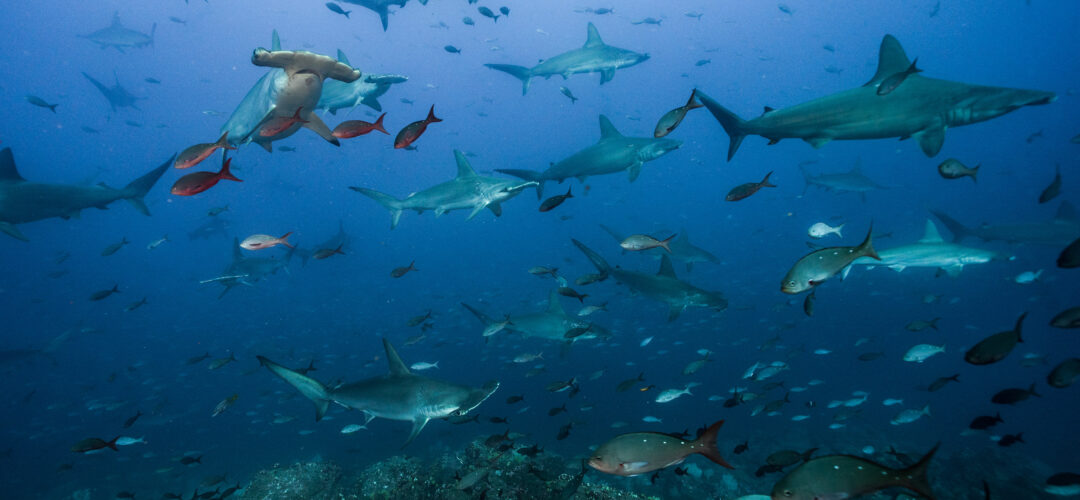The Call to Protect Ecosystems and Species: An Interview with Shark Conservation Fund
April 10, 2023
As part of Rockefeller Philanthropy Advisors’ new mission and values, we are featuring in-depth profiles of key sponsored projects to highlight their work in creating a just world. Shark Conservation Fund (SCF) is a collaboration of philanthropists dedicated to restoring ocean health through sweeping shark and ray conservation. Their goal is to help maintain the vibrancy of the world’s oceans by halting the overexploitation of sharks and rays and preventing extinctions through strategic, collaborative, and catalytic grantmaking.

Lee Crocket, Shark Conservation Fund
RPA spoke with the Executive Director of the Shark Conservation Fund, Lee Crockett, about SCF’s work. Lee discussed SCF’s origins, why shark conservation is an important environmental issue, and offered advice for funders looking to get involved in climate. This interview reflects edits for length and clarity.
What was the impetus for creating Shark Conservation Fund?
In 2015, a group of philanthropists were interested in shark conservation and thought they would be more effective if they worked together instead of individually. They pulled together like-minded philanthropists, set up a structure, and a pooled fund that they housed at RPA as a sponsored project. SCF began with five members, and they are up to eight now. They developed a strategy and operating rules, and formally announced the initiative at the Our Ocean Conference in Washington DC, September 2016. Leonardo DiCaprio, who was a founding member, addressed the conference and talked about the importance of shark conservation and the new collaborative, along with several other ocean issues. A majority of SCF board representatives are environmental lawyers or have backgrounds in environmental policy; they bring together decades of experience. A funder collaborative is beneficial because we take advantage of that pooled expertise, and the aggregate revenue allows us to do more than any single entity can do from a grantmaking perspective.
I was hired in January of 2017 as Executive Director. My first order of business was to develop a strategy that would guide our grantmaking for our first five years. We focused on regulating global trade, protecting the most endangered species, and combating unsustainable fishing.
How has your professional and personal background contributed to this work?
I came to this work from a background in policy development and advocacy. I started my career as an advisor to the US House committee that managed ocean legislation. From there, I developed an expertise in fisheries management in the United States, more specifically federal ocean fishery management (generally 3 to 200 miles offshore). I worked for the federal government and then in the NGO sector, running a coalition of environmental, marine science, and fishing groups that advocated for changes to the law that governed how our ocean fish are managed to make it more conservation-focused.
Once those amendments were passed, I transitioned to the Pew Charitable Trust. Pew had recently switched its tax status from private foundation to public charity, and they began hiring staff to run campaigns. I was one of the first hires at Pew to work on the development of regulations to implement the legislation that I had helped pass. After nine years working at Pew on implementation of the law, I was approached by Shark Conservation Fund. I was excited by the opportunity to try something different and enter the philanthropy space. Much of our work at SCF is related to fishery management, but here we are working with a particular suite of animals, and it is on an international scale.
Why is shark conversation such a pressing issue?
Sharks are top-level predators, and they play a crucial role in ocean ecosystems. There are plenty of examples in the terrestrial environment of the harm that is done when a top-level predator is removed. For example, in Yellowstone, wolves were killed off, causing the elk population to explode; the elk ate all the underbrush, altering the habitat which impacted all other animals. This same phenomenon occurs in the ocean. Work we are funding shows that seagrass beds—which are an important underwater habitat—are devastated without sharks. With sharks absent, grazers like turtles and dugongs clean out the seagrass, destroying the habitat that is so critical to healthy marine ecosystems. We argue that this demonstrates that sharks are a keystone species that are critical to the biodiversity of our oceans.
What is SCF’s strategy for protecting rays and sharks?
The biggest problem sharks face is overfishing; sharks are particularly vulnerable because they grow slow, mature very late, and produce few offspring. Their populations are declining, and the most recent global assessment of shark population health found that 37% are threatened with extinction primarily from overfishing – they are the second most endangered group of vertebrates in the world behind amphibians. Most overfishing takes place on the high seas and in developing countries which do not have the capacity to manage their sharks. Demand for shark fins, which are sold as a delicacy in China and other Asian countries, is a major driver of overfishing.
We realized quickly that addressing overfishing that is largely driven by trade in shark products needed to be a key part of our strategy. The Convention on International Trade of Endangered Species of Wild Fauna and Flora (CITES) is an international agreement signed in 1973 to ensure that trade in animals and plants does not threaten their survival in the wild. If a country wants to trade a CITES listed species, it needs to demonstrate that the trade is not detrimental to the species in the wild. This CITES requirement opens the door for us and our grantees to go into a country and help it better manage its shark populations. We have been putting a lot of money and effort into listing shark species in order to protect them from overfishing. Today, there are 141 species of sharks listed on CITES. Those protected species represent over 90% of the global fin trade. Listing species was the first step, we are now focusing on supporting the implementation of those listing in countries around the world.
The other big part of our strategy has focused on preventing extinctions, focusing on species that are threatened with extinction and endemic to particular areas and countries. If you map the distribution of these threatened endemic species, you see hotspots in the southwest Indian Ocean, the Southwest Atlantic Ocean, and the Coral Triangle. We fund work in countries in those areas in order to get legal protections in place. As a whole, we don’t fund a lot of research and if we do, it needs to have a direct connection to changing management. We are laser focused on changing laws and policies.
Are you working on any projects now that you’re particularly excited about?
There is an exciting new global initiative in the conservation world to adopt the 30 X 30 goal, to protect 30% of the planet’s land and waters by 2030. Lots of governments have taken on this challenge. There has also been a huge amount of philanthropic money pledged to meet this goal. But to maximize the conservation impact of these investments, biodiversity must be maintained and enhanced. To facilitate that, we have created the Shark Biodiversity Initiative, which will ensure that the effort and investment of money going into 30 X 30 will have a bigger biodiversity impact if sharks are protected. Sharks are an “umbrella species”, if you protect them many other species underneath them will also be protected.
We just launched this Initiative in the fall of 2022, but we are seeking partners. Partners can provide financial support for our work or collaborate with us to include shark conservation in their Marine Protected Area (MPA) projects. If a funder is planning to develop an MPA in a particular country, we want to work with them to get sharks specifically protected in those projects. Less than 2% of the MPAs around the world specifically protect sharks.
Part of this project involves working with the International Union for the Conservation in Nature (IUCN). They have a shark specialist group, and we funded them to identify important shark areas around the world. IUCN divided the world up into 13 regions, and they are conducting workshops in these regions where they bring top shark scientists together, all the relevant data that is available, and they decide which are the most important areas. We then vet these areas based on funder interest, potential government support and whether there is an NGO capable of executing the work.
In April 2022, RPA released a new framework for looking at philanthropic institutions, the Operating Archetypes. Where do you see Shark Conservation Fund fitting into this framework?
I see us as a designer. We created our strategy and put it out into the world where I think it’s had positive community impact. Our model has added some more direction to the NGO community. When we first started in 2016, there were lots of competing ideas on how to approach conservation. There was not a unified agenda for what ought to be done. We have been able to contribute and build cohesion in the community about what to work on. We have provided a forum and a framework, as well as funding, for those working in this space.
How have you centered community in your work, especially among your grantees?
We try to work from both ends of the policy spectrum. A good chunk of our work is top-down: the CITES’s listings, working with governments, etc. But we also have to work from the bottom up, starting at the community level. If the community is not on board with the work, long-term sustainability and success is not going to be realized. These two approaches often work hand in hand and influence each other. There are environmental groups that only focus on working with communities and trying to get them to enhance conservation, but that can be a slow process. We try to speed things up with legal prodding by going to the top level as well.
As a rule, we only support big international NGOs if they have a regional or a country-level office; we want the people that are actually doing the work to be citizens or residents of that particular country. That way, they have a better understanding of the country and a stake in it. Otherwise, our work would be people parachuting in from the US or Europe or Australia, and we know that that doesn’t work well. A vast majority of our money is going into support work carried out by NGOs at the national and local level in countries.
What is exciting you the most about the work that SCF does and what’s going on in the climate space in general right now? What advice would you give to a funder looking to get involved in climate or conservation action?
In the climate space most of the conversation is centered around reducing emissions and lowering carbon levels. And that is incredibly crucial. At SCF, though, we want to make sure that people are also talking about mitigating the impacts of climate change; that is where species conservation comes into play. Let’s face it: we’re going to be suffering from the impacts of climate change for centuries. Even if we stop emissions now, the carbon in our atmosphere is still there, and we will have to deal with the impacts of that. The ocean is uniquely affected by rising temperatures, because of acidification and other natural processes. If you have ecosystems in the ocean that are already stressed and lacking biodiversity, they cannot withstand these additional insults from climate change. Reducing carbon and protecting ecosystems cannot be an “either/or” situation. We have to do both, and you can’t effectively deal with the impacts of climate change if you’re not looking to protect ecosystems both on land and in the water.
Don’t forget about the species. Don’t forget about ecosystems. It’s a package deal. Effective involvement in climate action has to include protecting ecosystems, and protecting species as part of that.
Photo by PACIFICO Foundation & Migramar
Back to News



